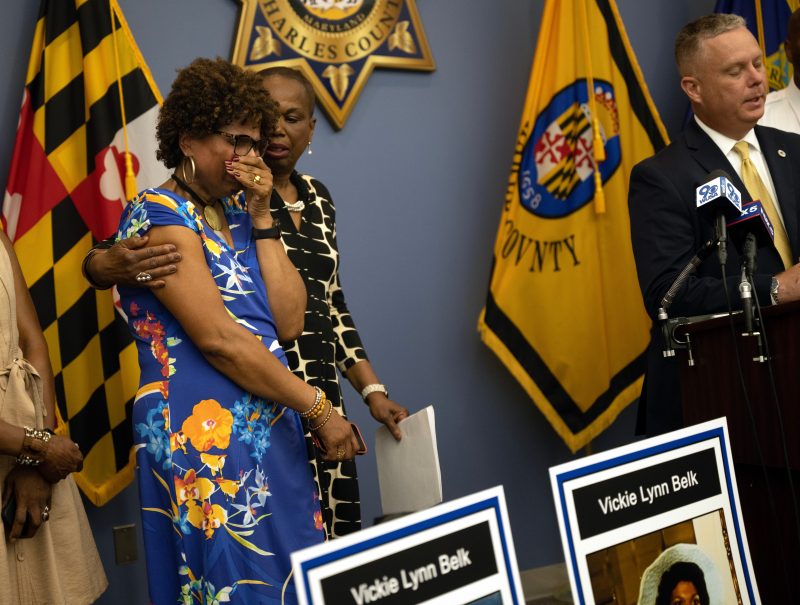On a summer evening in 1979, long before the advent of DNA evidence, a 28-year-old federal worker named Vickie Lynn Belk, who had been abducted in the District, was found dead beside a rural road in Southern Maryland. She had been raped and shot, and for decades her attacker’s identity was a mystery to detectives.
Such a promising life had been snuffed out.
A child of the civil rights era, Belk, as a third-grader in 1960, had been among the first group of Black pupils to integrate the Alexandria, Va., school system. The four youngsters were empowered by a judicial decree issued during Virginia’s “massive resistance” campaign against the U.S. Supreme Court’s 1954 desegregation ruling in Brown v. Board of Education. Belk went on to become the first in her family to graduate from college, one of her sisters said.
Now, owing to trace amounts of semen discovered on her long-preserved dress and slip, the cold case has been solved through DNA testing, authorities in Charles County said Thursday in announcing the arrest of a 62-year-old D.C. man.
With nearly a dozen of Belk’s relatives, some from as far off as Texas and California, assembled in the county sheriff’s headquarters for a news conference, her only child, Lamont Belk, who was 7 at the time of the killing, stepped to the lectern.
“I just thank God for allowing us to be alive to bear witness to this momentous occasion,” said the son, now a gray-haired 51-year-old. He is a lawyer for the Tennessee Valley Authority and former federal prosecutor in Georgia. “Our community is a little bit safer today with this person behind bars,” he said.
The accused killer, Andre Taylor, was a few months shy of his 19th birthday when Belk, a management analyst for the Department of Agriculture, was abducted from a parking lot near the Stadium-Armory Metro station in Southeast Washington on Aug. 27, 1979. Two days later, a teenager riding his bike along a tree-lined thoroughfare 25 miles south of the city saw her body in the brush.
Sheriff Troy D. Berry and others in the department described how investigators benefited from advancements in DNA technology and record-keeping in the past 44 years to identify the alleged culprit. When detectives arrested Taylor late last month, he was in a D.C. “nursing and rehabilitation facility” in failing health, an amputee with one leg, according to an official who spoke on the condition of anonymity to share medical information.
Taylor, who is being held without bond, was charged with rape and first-degree murder in a sealed indictment June 16 and was arrested soon afterward, authorities said. Court records do not indicate whether he has entered a plea. The Maryland public defender’s office, which is representing Taylor, declined to comment.
When Belk was killed, law enforcement agencies hadn’t yet begun using DNA science as an investigative tool. The technology wasn’t born until the 1980s, after which federal authorities started building a now-vast database of DNA samples, akin to fingerprint files, from people charged with crimes all over the country.
In Belk’s case, evidence collected at the crime scene and during an autopsy was saved in storage: her pantyhose and brown shoes, some hair samples and nail clippings, her jewelry and bra, and her dress and slip, according to a police affidavit filed in court. “The investigation continued in the subsequent months and years, however no suspect(s) were identified,” a detective wrote in the affidavit.
Two decades went by. In the early 2000s, “Several pieces of evidence were tested for DNA … and a partial semen profile was located on Belk’s dress,” the affidavit says. But testing technology was still early in its development, and “the profile was not suitable to be entered into any database or compared to any suspects.”
Meanwhile, in the District, Taylor, who was a stranger to Belk, amassed a long record of arrests in the years after her body was found. Although most of his alleged crimes were nonviolent, and some of the cases were dismissed, he was charged with murder in April 1989 after D.C. police said he fatally shot a man during a street robbery.
In arguing that Taylor should be held without bail in that killing, a prosecutor told a D.C. Superior Court judge, “Mr. Taylor has no less than 10 prior convictions,” including for drug and gun possession. In the homicide case, he was found guilty only of carrying a pistol without a license, but as a repeat offender, he got a relatively stiff sentence: five to 15 years in prison.
After his release, Taylor was arrested in the District several more times in the 2000s, and at some point his DNA was entered into the federal database, known as the Combined DNA Index System, or CODIS, authorities said.
“As forensic technology advanced, the evidence in Belk’s homicide continued to be reexamined and tested,” the affidavit says. “In 2022, Belk’s dress and slip were tested again using new technology, which resulted in a male DNA profile being identified from semen that was found on her dress and slip.”
When the newly developed profile was compared with profiles in CODIS, it matched Taylor’s, the affidavit says. The sheriff’s office was notified of the results in November, and detectives began a deep dive into Taylor’s background, including his criminal history. Sgt. John Elliott, an investigator, said records from one of Taylor’s arrests, in the 1980s, listed his residence as an aunt’s home in Charles County, less than four miles from where Belk’s body was found.
In March, needing more verification, detectives with a search warrant confronted Taylor in the nursing facility and took a swab of his saliva for a fresh comparison with the crime scene DNA, according to the official who spoke anonymously. Although the visit alerted Taylor that he was a suspect and it would take weeks for the lab tests to be done, authorities weren’t worried about him fleeing.
Given his medical ailments and amputation, “he wasn’t going anywhere,” the official said. Last month, after tests again confirmed the DNA match, authorities said, Taylor was indicted. Elliott described the killing as “random” and said Taylor is not a suspect in any other abductions.
On Aug. 27, 1979, investigators said, Belk and her boyfriend, James Hill, also an Agriculture Department employee, followed their morning routine: They rode in Hill’s 1972 Buick from their apartment in Prince George’s County to the Stadium-Armory station, where they left the car and took a train to their offices. Belk told Hill (now deceased) that she planned to use the car to run errands at lunchtime and would meet him in the parking lot after work.
She never returned from lunch.
When Hill arrived at the lot, Belk wasn’t there and the car was gone. That night, he “checked with several friends and family of Belk, however no one knew where she was,” the affidavit says. The next morning, he reported her missing. And the day after that, Aug. 29, the teenager riding his bike spotted her body at the edge of woods near Bryans and Metropolitan Church roads in Charles County.
“The victim was laying flat on her back, legs extended and … with her fists clenched up around her collarbone as if warding off an attacker,” a sheriff’s report noted. She had been raped and shot in the head. As for the Buick, it turned up in D.C., abandoned.
Two weeks earlier, Belk, who was the eldest of six siblings and a graduate of Saint Augustine’s University in North Carolina, had been her sister Judy’s maid of honor.
“The last time I saw Vickie was my wedding day,” Judy Belk-Peeks, 70, said at the news conference. She is chief executive of the California Wellness Foundation in Los Angeles. Among the relatives standing with her were another of the victim’s sisters, a retired homicide detective in California, and a nephew who is a police officer in Texas. “I was not a parent in 1979,” Belk-Peeks said. “And now that I am, I can’t imagine the process of bearing the loss of your child.”
She spoke of her parents, Lonnie and Maydell Casey Belk, who died years ago without getting justice for their firstborn.
In Alexandria in the late 1950s, before desegregation, Maydell Casey Belk “didn’t see herself as a social activist until one too many rainy mornings drenched her two oldest daughters as they waited for an overdue school bus that would take them across town to an all-black elementary school,” according to her 2005 obituary in The Washington Post. “An all-white school was just two blocks away.”
The daughters were Judy and Vickie.
Their mother joined an NAACP lawsuit that forced Alexandria to abide by Brown vs. Board of Education. In 1960, Judy and Vickie, first- and third-graders, respectively, and two other Black children entered Minnie Howard Elementary School, shattering a racial barrier.
When she thinks of her murdered sister, Belk-Peeks said in a halting voice, she remembers that day.
“There was concern that there would be violence,” she recalled. “The community groups said: ‘Just be prepared. Just walk straight. Judy, just hold onto Vickie’s hand.’ They said people might spit on you. They might call you the n-word. None of that happened. But Vickie held my hand, and she checked in on me. She always did.”



























